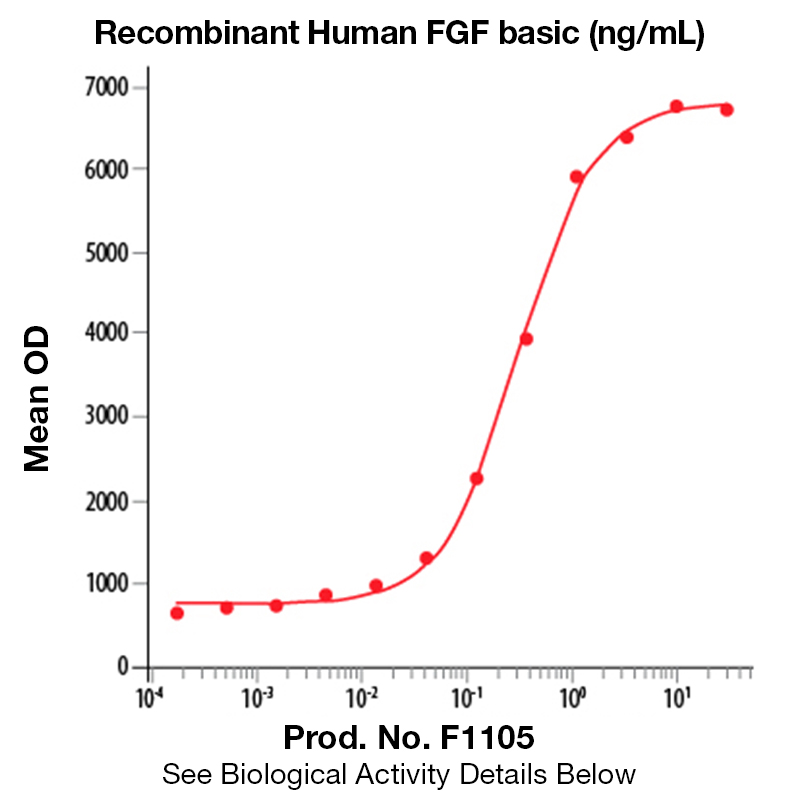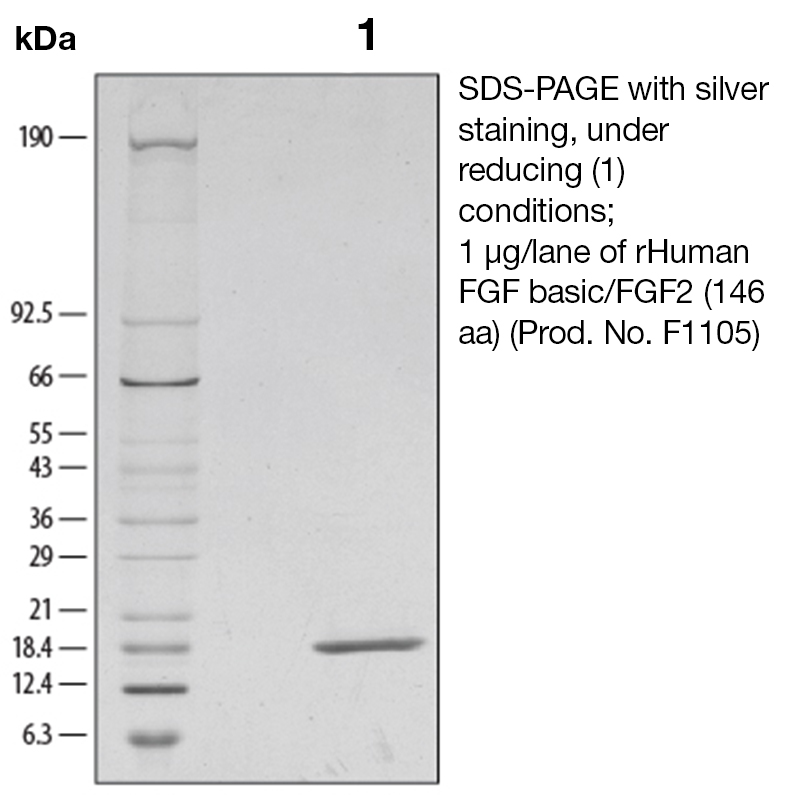Recombinant Human FGF-Basic (146 aa)
Data
- -
- -
BackgroundBasic fibroblast growth factor (bFGF), also known as FGF-2 and FGF-β, is a non-glycosylated heparin binding growth factor and member of the FGF family of mitogenic proteins. Members of this family play a central role during prenatal development, postnatal growth and regeneration of a variety of tissues, by promoting cellular proliferation and differentiation (1). bFGF is expressed in the brain, pituitary, kidney, retina, bone, testis, adrenal gland, liver, placenta, and monocytes, epithelial and endothelial cells. It is secreted by mechanisms other than the classical protein secretion pathway due to the lack of a signal peptide. Acidic FGF (aFGF) and bFGF bind to the same high affinity receptors (2). Binding of bFGF to heparin or cell surface heparan sulfate proteoglycans is a prerequisite for ligation of bFGF to these receptors. aFGF and BFGF have a similar range of biological activities which are implicated in several important physiological and pathological processes, such as embryonic development and differentiation, morphogenesis, angiogenesis, and wound healing (3-4). Protein DetailsPurity >97% by SDS-PAGE and analyzed by silver stain. Endotoxin Level <0.1 EU/µg as determined by the LAL method Biological Activity The biological activity of Human FGF basic (146 a.a.) was determined in a cell proliferation assay using NR6R3T3 mouse fibroblasts. The ED<sub>50</sub> for this effect is typically 0.5-2.5 ng/ml. Protein Accession No. Amino Acid Sequence palpedgg sgafppghfk dpkrlyckng gfflrihpdg rvdgvreksd phiklqlqae ergvvsikgv canrylamke dgrllaskcv tdecffferl esnnyntyrs rkytswyval krtgqyklgs ktgpgqkail flpmsaks N-terminal Sequence Analysis Ala-Pro143 State of Matter Lyophilized Predicted Molecular Mass The predicted molecular weight of Recombinant Human FGF-Basic is Mr 16.0 kDa. However, the actual molecular weight as observed by migration on SDS-PAGE is Mr 17 kDa. Predicted Molecular Mass 16.0 Formulation This recombinant protein was 0.2 µm filtered and lyophilized from a sterile solution containing 20 mM Tris, 1000 mM NaCl pH 7.0. Storage and Stability This lyophilized protein is stable for six to twelve months when stored desiccated at -20°C to -70°C. After aseptic reconstitution, this protein may be stored at 2°C to 8°C for one month or at -20°C to -70°C in a manual defrost freezer. Avoid Repeated Freeze Thaw Cycles. See Product Insert for exact lot specific storage instructions. Country of Origin USA Shipping Next Day Ambient NCBI Gene Bank Applications and Recommended Usage ? (Quality Tested by Leinco) ELISA Sandwich: This antibody is useful as the capture antibody in a sandwich ELISA. The suggested coating concentration is 5 µg/ml (100 µl/well) µg/ml. Flow Cytometry: PN:A106 Flow Cytometry: It is recommended to use the indirect method for signal enhancement when enumerating cells expressing CXCR5. A suggested method would be to stain cells expressing CXCR5 with approximately 10 µl per test. A typical test sample constitutes approximately 50 µl of packed whole blood or 1 x 105 continuous passage or activated cell cultures that have been centrifuged at 500 X g for five minutes. Labeling of the cells with the biotin conjugate should be followed by PN:A104, resuspended in 200-400 µl of 1X PBS. References & Citations1. Swain, JL. et al. (1991) Developement 111: 741 2. Grevers, G. et al. (1997) Laryngorhinootologie 76: 421 3. Bühring, HJ. et al. (2007) Differentiation. 75(4):279-91 Technical ProtocolsCertificate of AnalysisIMPORTANT Use lot specific datasheet for all technical information pertaining to this recombinant protein. |
Related Products
- -
- -
Prod No. | Description |
|---|---|
F149 | |
F1105 | |
F107 | |
F110 | |
F1022 | |
F1027 |




